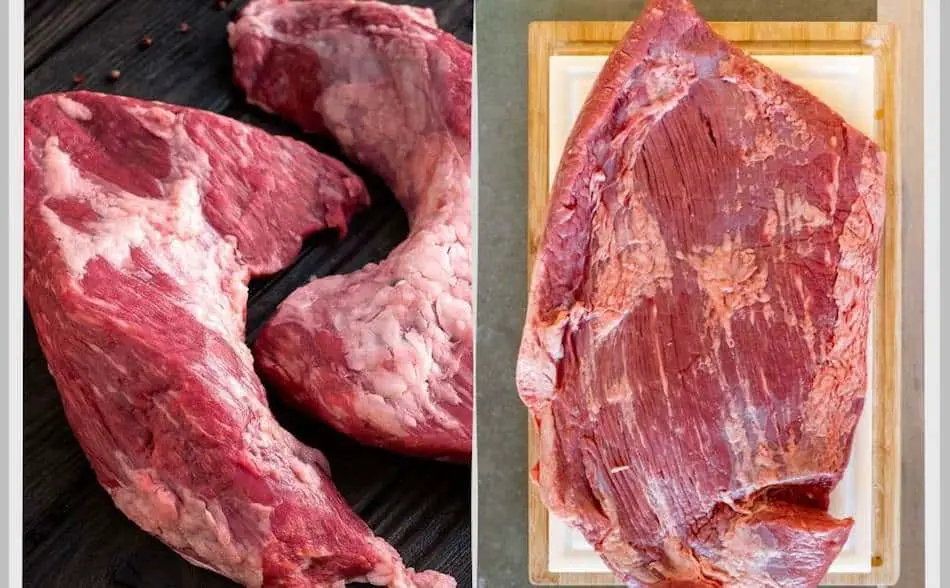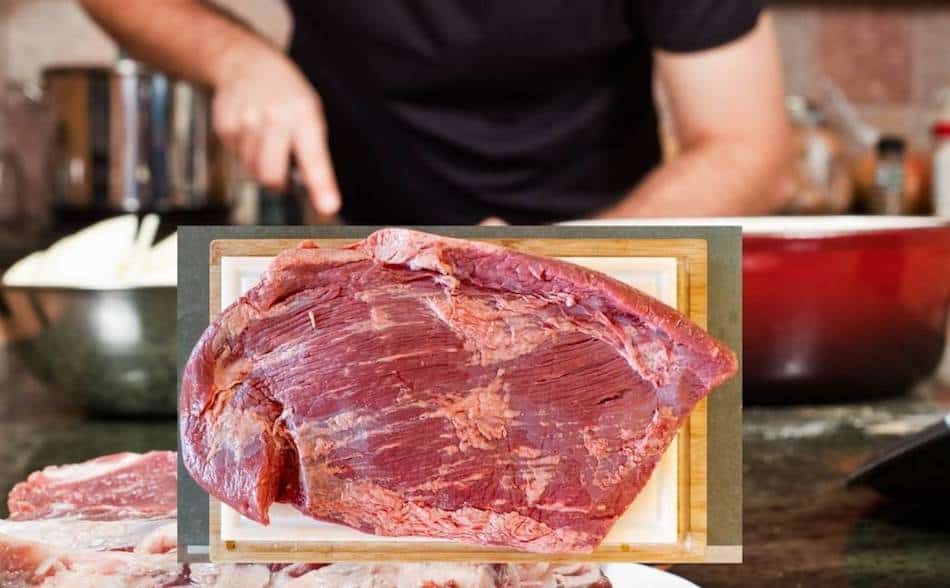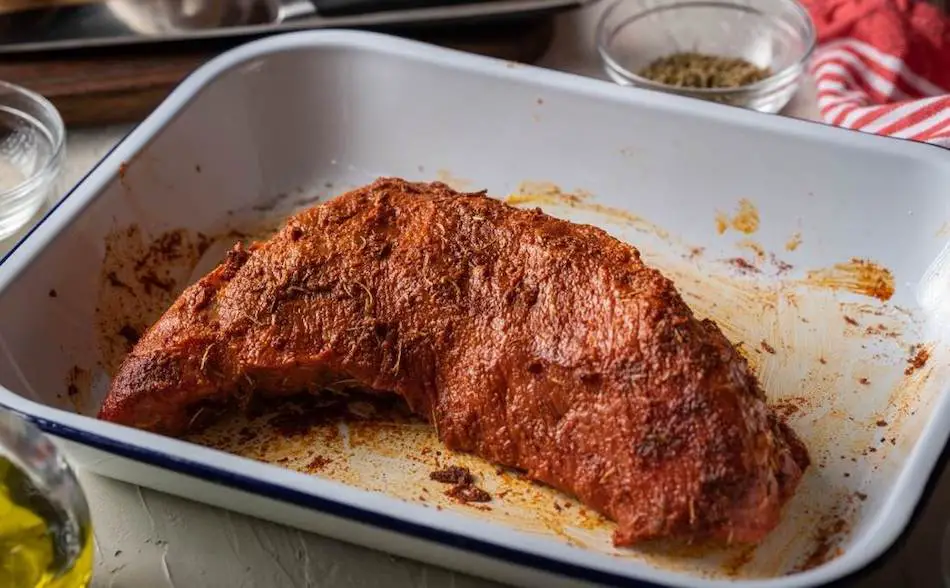
Tri-tip and brisket are two cuts of beef that come from the same animal but have distinct differences in terms of texture, fat content, and connective tissue. As a result, they require different cooking methods to achieve optimal flavor and tenderness. In this article, we will take a closer look at the differences between these two cuts, as well as the best methods for cooking and preparation.
Tri-tip and brisket are two cuts of beef from the same animal that differ in terms of texture, fat content, and connective tissue. Brisket is a large cut that needs to be cooked low-and-slow for several hours, while tri-tip is a small, lean cut that can be cooked quickly through a reverse-searing method. Brisket has a rich flavor due to its high fat content, while tri-tip has a milder flavor similar to sirloin steak. Brisket can be just as tender as tri-tip if cooked correctly, but tri-tip is naturally more tender. Brisket contains more fat than tri-tip and is larger in size. Marbling, which refers to the fatty striations within the meat, is determined by the beef grade and can be influenced by purchasing Prime or Choice grade or Wagyu beef.
| Beef Cut | Cooking Time | Weight | Fat | Connective Tissue |
| Brisket | 10-15 hours | 5 to 16 lbs | High | High |
| Tri-Tip | 2 hours | 2 to 3 lbs | Low | Low |
Key Points
- Tri-tip and brisket are two cuts of beef that come from the same animal but have distinct differences in terms of texture, fat content, and connective tissue.
- Brisket needs to be cooked low-and-slow over several hours, while tri-tip is a small, lean triangular cut of beef that can be reversed-seared in under 2 hours.
- Brisket is a large cut, full of gristle and high in fat and connective tissue, while tri-tip is a smaller cut with less connective tissue and lower fat content.
- The taste of brisket and tri-tip depends on how it is cooked. Brisket is known for its rich flavor due to its high fat content, while tri-tip has a milder flavor, similar to sirloin steak.
- Tenderness-wise, brisket can be just as tender as tri-tip if cooked correctly, but tri-tip is naturally more tender due to its lower connective tissue content.
- Brisket contains more fat than tri-tip, which can make it more flavorful but also more difficult to trim.
- Marbling refers to the fatty striations within the meat, which gives it flavor and moisture. The marbling is determined by the beef grade, not the cut. Choose Prime or Choice grade meat for more marbling, or Wagyu beef for the highest level of marbling.
- Brisket is a much larger cut of meat than tri-tip, with a small brisket weighing around 5 lbs and a large brisket weighing around 15-16 lbs.
The Main Differences
Tri-tip and the brisket are very different cuts of meat. Both are common in barbecue, and very popular barbecue meats. These two cuts of beef are best cooked low-and-slow. Brisket is a large cut, full of gristle, so it will need to cook over 10 to 15 hours — even longer. A Tri-tip is a smaller cut with less connective tissue, and will only take about 2 hours to cook.

What Tastes Better?
The taste of brisket and tri-tip depends on how you cook it. If you cook a brisket low and slow, many would argue it has a better flavor than a tri-tip. The reason brisket is so popular is that lots of fat and connective tissue that renders and melts, it turns into gelatin which gives me an amazing flavor and texture. Tri-tip is naturally lean and doesn’t contain that connective tissue, so it’s going to have a different flavor. However, if you’ve had sirloin steak, or sirloin roast, then the tri-tip will taste similar because it’s part of the same muscle group.
Cooking Time – Brisket vs Tri Tip
A tri-tip only takes about 2 hours to cook if you’re using a smoker or a pellet grill. A brisket will take anywhere between 8 to 18 hours depending on the size of the brisket. Most pitmasters will use a reverse-sear method with tri-tip, which involves smoking the meat low-and-slow for about 1 hour, and then finishing over high-heat to sear both sides.

The Tenderness Test – Who Wins?
A brisket contains more connective tissue, so is technically less tender. However, if cooked correctly, brisket can be just as tender as a tri-tip.
The tri-tip is part of the sirloin, which is a more tender cut than the brisket. The sirloin and tri-tip contain very little connective tissue or fat, which means it will be more tender. Brisket is full of sinew, and connective tissue, which will make the meat chewy if not cooked correctly.
Is Brisket Fattier Than Tri-Tip?
Brisket contains more fat than a tri-tip, which has its pros and cons. Since the tri-tip is leaner, it has less flavor and may dry out easier. Brisket will have a thick fat cap on top, and usually needs to be trimmed down to about a quarter of an inch. You get a lot of wastage if you buy a fatty brisket, because most of the fat needs to be removed.
What About Marbling?
When shopping for brisket or tri-tip, take notice of the beef grade, as this is related to the level of marbling. The fatty striations within the meat give it flavor and moisture.
The marbling is determined by the beef grade rather than the cut. If you want more marbling in your meat, purchase Prime or Choice grade meat. If you have the money, then buy wagyu beef, which is famous for its higher level of marbling. Select grade beef will have very little marbling, usually none, so it will have less flavor and dry out easier.
Have you tried smoking a Wagyu brisket yet? You can get one delivered to your door from Snake River Farms.
What’s Bigger?
Brisket is a much larger cut of meat when compared to a tri-tip. Brisket is a large roast, whereas the tri-tip looks more like a large, thick steak. A large brisket weighs about 15 or 16 pounds. A small brisket might only weigh around about 5 lb if you just get the flat muscle. Tri-tip on the other hand, will only weigh about two or three pounds.
What Costs More? Brisket or Tri-Tip?
Tri-tip is more expensive per pound, but a brisket will cost more money because it is a large quantity of meat. You might pay $80 for a whole brisket, but you get a twin pack of tri-tips for about $50. Check latest price at Sam’s Club here.
You will see Choice grade Angus tri-tip at places like Sam’s Club for around about $8 per pound. Check prices as they change frequently. A Choice Angus brisket at the same butcher will be around about $4 a pound. Obviously price is very, from store to store and can change often.
Availability
Briskets are very common, and can be found in most butchers and most meat sections of supermarkets—but tri-tip is a different story.
You may have to search around for a cut of tri-tip—not all butchers will sell it. Once upon a time, you could only find a tri-tip in southern California. However, it has gained popularity and you can buy it at Sam’s, Costco, another major store. Ask your butcher to cut you off the tail of the sirloin, and he’ll probably charge you the same price as sirloin steak.
Brisket Has More Connective Tissue
Brisket if from a hard-working part of the animal, so it contains a lot of connective tissue and sinew, etc. If you were to cook brisket at a higher temperature, it would be almost inevitable. Brisket needs time at low temperature to melt all that connective tissue.
Tri-tip contains very little connective tissue, because it’s connected to the sirloin, which is a lean cut of beef.
Where Are Tri-Tip and Brisket From?
The tri-tip is from the sirloin, which is the rump section of the animal. This muscle is part of the hindquarter, or the rear of the animal. The brisket is part of the four-quarter, the front part of the animal. More specifically, the brisket is the pectoral muscle, or the chest. The sirloin is the rump or the rear end.
So because tri-tip and the brisket are different muscles, they will have a different level of fat and connective tissue and tenderness.
How To Cook Brisket
- Trim your brisket leaving 1/4 range of fat on the top.
- Cover your brisket with a barbecue wrap or a simple salt and pepper mix.
- Set the temperature of your oven or smoker to 225° F to 250° F
- If you’re smoking, throw on some hickory or mesquite or oak wood.
- Cook the brisket low and slow for the first 5 or 6 hours and then remove from the heat and wrap in aluminium foil.
- Continue cooking the brisket until the internal meat temperature reaches 203° F.
For more information on how to cook a brisket, check out this article, which is a full guide with all the tips and tricks from some of the world’s best pit masters to help you absolutely nail your brisket.
How To Cook Tri-Tip
- Tri-tip is best cooked using the reverse-sear method and is usually served medium to rare.
- Cover the tri-tip with your favorite barbecue rub or just use salt pepper and garlic powder.
- Set your smoker or oven to 225° F and cook the tri-tip for about an hour and a half until the internal meat temperature hits around about 115° F.
- Finish the tri-tip over high heat using the reverse sear method. Sear the tri-tip on both sides for about three or four minutes or until the tri-tip hits around about 130° F or 140° F.
My Favorite Brisket Tools
Thanks for checking out this article. I hope you learned a few things. Here are some of my favorite tools I use when smoking brisket that may be useful to you. These are affiliate links, so if you decide to purchase any of these products, I’ll earn a commission. But in all honesty, these are the tools I recommend to my family and friends who are just starting out.
Meat Injector: Injecting meat is a great way to take your barbecue to the next level and help you make competition-style brisket. An injector is the only way you will be able to get flavor and moisture into the middle of the meat. The Beast Injector is a stainless steel injector that is sturdy and affordable. Check the latest price on Amazon here.
Brisket Marinade: The best injection solution on the market is the Butcher BBQ Brisket Injection. This marinade is used in competitions and is made by World Barbecue Champion pitmaster, Dave Bouska. You can find the marinade on Amazon here.
Butcher Paper: Wrapping brisket in butcher paper has become a huge trend in barbeque thanks to Aaron Franklin. Wrapping your brisket in paper will give you a nice brisket bark. However, you can’t just use any old paper, it has to be unwaxed, food grade paper. You can find it on Amazon here.
Brisket Rub: These days I make my own rub when possible, but I always have a few pre-made rubs for when I’m running low. Barbecue guru Malcom Reed produces Killer Hogs, one of the best brisket rubs I’ve found over the years. Another great rub is Slap Yo Daddy, made by brisket master and multiple World Barbecue Champion, Harry Soo.
Meat Thermometer: There are dozens of fancy thermometers on the market, but I still use my trusty TP20. For around $50, I have a high-quality meat thermometer with two probes, and can track the temperature of my smoker with one probe, and my meat with the other probe. The ThermoPro TP20 is an Amazon Best Seller because it’s the easiest thermometer to operate, is durable, highly accurate, and comes with pre-programmed meat settings.
Instant Read Thermometer: Arguably, the second most important tool you need is a fast and accurate instant-read thermometer. These tools play an important role in the latter stages of the cook when the meat needs regular checking in multiple areas. I use the ThermoPro TP19 because it can do everything a ThermaPen can do, but for a fraction of the cost. You can check out the TP19 on Amazon here.
Advanced Thermometer and Automatic Temperature Controller: Once you’re ready to take things seriously, the FireBoard 2 Drive is a six-channel Bluetooth/Wi-Fi thermometer that can monitor up to 6 pieces of meat, control and graph your cook sessions on your smartphone, and attaches to an an automatic blower that will convert your charcoal smoker to a set-and-forget. This is one of the most advanced meat thermometers on the market. You can check it out on the FireBoard website here.
